In part 3 we take us from 1825 -1860.
(A good source in creating this chronology has been SPUMS Journal Volume 29 No.2 June 1999. Spums Archive
If you have the rights to any of the images used to illustrate the material, please contact us through our contact form , we will give you credit for the image, or remove it if you wish.)
1825 William James
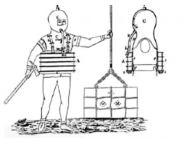
William James’ equipment for compressed air diving (pressurized to 30 atmospheres absolute pressure or ATA) had its air tank attached around the diver’s waist. The diver regulated his air supply with a hand-operated valve. Ventilation was done through a valve on the diver’s helmet. This was probably the first diving equipment with its own air supply 24 .
1825 Johan Patrik Ljungström
JJohan Patrik Ljungström, born 1784 in Stockholm, died 1859, was a Swedish jeweler, inventor and diving pioneer. He was Sweden’s first private diver. Spurred on by a statement by the Swedish expert Rosenberg about the impossibility of reaching a particularly inaccessible shipwreck, Ljungström had a diving watch made of tinned copper, equipped with a compass and with room for a crew of 2-3 people and with communication possibilities through signaling equipment. In 1825, the diving bell was sunk about 16 meters with Ljungström and an assistant on board. ”This thing,” reports a town hall protocol, was ”so well conceived by Ljungström for its convenience, to be allowed to go down to the seabed unabashedly, that it supinated the whole Society, most of whom were spectators.” In 1827, Ljungström wrote ”Some notes, concerning the diving and pilot facilities”, where he presented ideas for the introduction of a private sector corresponding to the former state diving companies.”25.
1828 Paul Lemaire d’Augerville
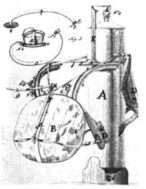
Paul Lemaire d’Augerville, was a French dentist who developed a diving equipment by designing a copper cylinder for breathing air built into a backpack. It was also connected to an inflatable life jacket. The system was used successfully down to a depth of 20 meters for up to an hour. The mask was made of copper and lined with dental cement to provide a good seal. The diver’s buoyancy was controlled by using the contents of the air tank and ballast weights 26 .
1829 Charles Anthony Deane
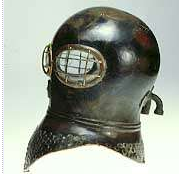
Charles Anthony Deane saved all the horses in a stable in 1820 by wearing a medieval knight’s helmet as protection against smoke and flames. Air was pumped into the helmet with one of the fire service’s hand-operated water pumps. He developed his idea and patented it as a smoke diver’s helmet. The sale did not go any further, which is why he and his brother in 1828 converted it into a diving helmet which they sold together with what was probably the world’s first diving suit. However, the diver could only work in a vertical position, otherwise the helmet was filled with water. In 1836, the Deane brothers published the world’s first dive manual entitled ”Method of Using Deane’s Patent Diving Apparatus”
In 1836, the Deane brothers published the world’s first dive manual entitled ” Method of Using Deane’s Patent Diving Apparatus ” 27 .
1834 – 1877 Pressure chamber
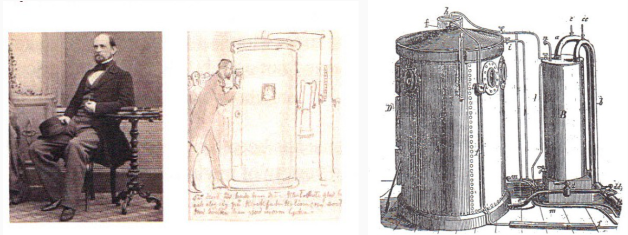
Several different pressure chambers were manufactured around Europe during the period. All to treat various non-diving-related illnesses and injuries 28 . This was often called ”air bath”. Active in Stockholm was Dr Oscar Theodor Sandahl. One of two pressure chambers used by Sandahl for a ”compressed air bath” in 1860 in Stockholm. The compressor used was 3 hp and delivered air at max 200 kPa (1 ata)
(Edited note. The vessel to the right is a cooler of the hot air from the compressor. The chamber had a diameter of 1 m and was approximately 2 m high.)
1835 John Bethell
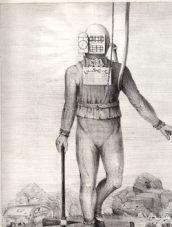
Bethell receives British patent no. 6757 and thus becomes the first to obtain a patent for a dry suit. At this time there were several who made heavy diving equipment, the most well-known besides Bethell, the brothers Deane and Siebe.
During the cleaning of the wreck after HMS Royal George outside Portsmouth in 1839, all of the three mentioned suit types were used. The leader of the work, the colonel of the Royal Corps of Engineers, Charles Pasley, decides to do a comparative test between them. He excludes the Dean equipment as he believed that it, with its helmet, which was open in the lower part, entails a greater risk for the diver. He then excludes Bethell’s equipment because it was too cumbersome and takes too long to put on, and then recommended that Siebe’s equipment be used for all future diving work29, 30, 31, 32.
1839 August Siebe

August Siebe was contacted by the Deane brothers as early as 1830 to improve their diving equipment. In 1839 he came with his own. A helmet with associated costume in rubberized canvas. The suit that kept the diver completely dry was provided with a chest plate to which the helmet was attached using a neck ring, which made taking off and putting on much faster and easier. Sibe’s design with a closed combination of costume and helmet revolutionized all dive values and can be said to be in effect also today 33 .
1841 Jaques Triger
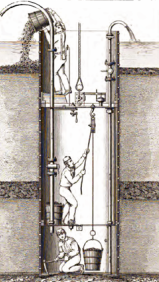
Although Von Derschau’s came up with the idea of ”lifting” water using air as early as 1826 and Cochrane patented the method in 1831, Frenchman Jaques Triger is considered to be the inventor of the caisson. The caisson he constructed consisted of interconnected iron cylinders, with a diameter of 1 meter and each cylinder six meters long. The invention of the airlock, which allowed the material to be transported to the surface without the pressure being lowered in the work department, offered great benefits. They worked down to about 20 meters depth among other things coal. The method was then used relatively diligently. For example, in the construction of the Brooklyn Bridge in 1870 and for two of the foundations on which the Eiffel Tower rests 1887.
In 1845, Triger wrote a report in which problems of descent, ear pain, and the rate of breathing decreased. He also noted the first two known cases of decompression sickness 34 . (Reds. Note. even though they did not know what decompression sickness was or was due to.)
1846 – 1865 Pol, Wattelle and others
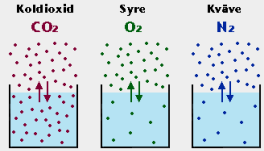
During the period, several cases of decompression sickness were reported in case of caisson work. Several people, for example, the French Pol and Wattelle (1847), Littleton (1855), and Bucquoy (1861). Suggest a slower decompression. Bucquoy was probably the first to publish an account of the dangers of working in compressed air environments 31, 32 .
1859 Fahnehjelm
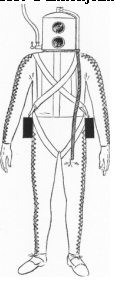
In the summers, Fahnehjelm worked as a machine officer on crown steamboats. When the crown steamer Odin resigned to London in 1836, Anton Fahnehjem worked on it. On his return journey, Odin ended as a wreck the coast of Jutland and during the rescue work, Fahnehjelm began to think about diving equipment. On his return, he moved to Stockholm in 1837 and took up employment at the Fleet Mechanical Corps. He took over and expanded the rubber factory that was built by Immanuel Nobel and began to manufacture both diving suits and helmets there. In 1839 he obtained a patent for his diving equipment. In 1843 he recovered from Lake Yxnaren one barge at a depth of 16.5 meters, in the submerged with a weight of 6.8 tons.
As early as the 1830s, Fahnehjelm had manufactured self-igniting mines. He developed this for blasting underwater with electrical ignition and was granted a patent on the method in 1843. It was widely used in ports and waterways. Fahnehjelm himself carried out such a cleaning of the Kodjupet outside Stockholm 33.
In 1854 Fahnehjelm led the work on the Swedish side in the closure of the underwater cable between Skåne and Jutland. 34, 35 .
References
Please note that many of the references are to Swedish pages or books.
24. Davis RH. Deep Diving and Submarine Operations Part 1 and 2, 9th edition. Gwent: Siebe Gorman and Co Ltd, 1995
25 Johan Patrik Ljungström . Visited 20200426
26. Paul Lemaire d’Augervillem. Besökt 20200426.
26. Paul Lemaire d’Augervillem. Visited 20200426.
27 Anthony Deane . Visited 20200426
28. Jain KK. The History of Hyperbaric Medicine. In Textbook of Hyperbaric Medicine. 2nd edition. Jain KK. Ed. Seattle: Hogrefe and Huber, 1996.
29 August Siebe . Visited 20200427
30.Triger. Visited 20200428
31. Oxley R. A short History of Caisson Tunnelling Report to the Melbourne and Metropolitan Board of Works. August 1969. Thalmann ED. Principles of U.S Navy recompression treatments for decompression sickness. In Management of Diving Accidents.
32. Bennett PB and Moon RE, Eds. Bethseda, Maryland: Undersea and Hyperbaric Medical Society, 1990: 194-221.
33. Fahnehjelm. Visited 20200428
34. Fahnehjelm. Visited 20200428
35. Fahnehjelm. Visited 20200429.
